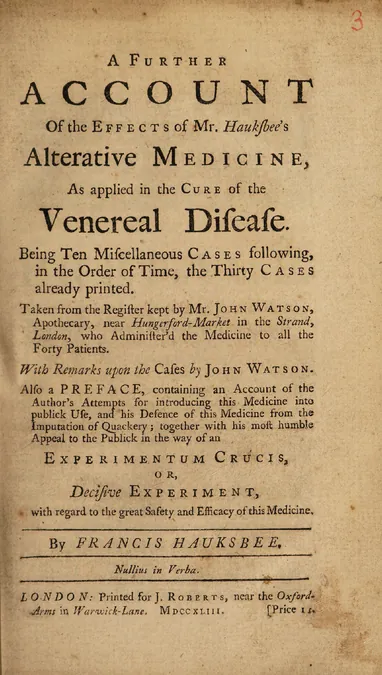
The Unsung Hero of Modern Medicine: Francis Hauksbee the Younger's Revolutionary Clinical Trial Concept
2025-01-25
Author: Rajesh
Introduction
In an intriguing look at the history of clinical trials, researchers from Brighton and Sussex Medical School and the Royal Sussex County Hospital have shed light on the groundbreaking work of Francis Hauksbee the Younger. Their analysis focuses on Hauksbee's 1743 pamphlet, "Experimentum Crucis," which is lauded as a pioneering effort in the realm of systematic medical testing.
The Revolutionary Concept of Clinical Trials
Hauksbee, an 18th-century instrument maker and scientific lecturer, proposed a structured approach to assessing the "safety and efficacy" of his alternative treatment for venereal disease. This methodology was revolutionary for its time, marking an early attempt at what we now recognize as clinical trials. His pamphlet detailed a plan that involved a controlled study designed to compare his treatment against standard therapies used at that time.
Medical Practices in the 18th Century
In an era when controlled medical trials were virtually unheard of, Hauksbee's initiative was groundbreaking. Medical practice during the 18th century primarily revolved around anecdotal evidence, with physicians often publishing opinion pieces akin to modern advertisements. Many treatments were unverified, including the use of mercury, arsenic, and various plant toxins that were widely regarded as cures, despite their often dangerous side effects.
Hauksbee's Response to Criticism
Hauksbee's proposal emerged amid skepticism regarding new medical treatments, with critics labeling him a "quack." To combat these accusations, he aimed to conduct a rigorous trial pitting his non-mercury "alterative" medicine against conventional remedies, which relied heavily on the controversial salivation therapy associated with mercury—famous for its severe adverse reactions.
Proposed Methodology of Hauksbee's Trial
The research published in the journal *Notes and Records: the Royal Society Journal of the History of Science* highlights the meticulous methods outlined in Hauksbee's proposed trial, drawing parallels to later studies, such as James Lind's famous scurvy trial in 1747. Lind’s experiment is widely recognized as one of the first proper clinical trials, involving twelve sailors and six different treatments for scurvy.
Hauksbee's methodological framework was notably sophisticated. He suggested selecting 12 patients with "curable degrees" of venereal disease, dividing them into two groups of six: one receiving his treatment and the other receiving standard care. His plan emphasized controlling variables—such as diet and living conditions—to reduce potential confounding factors. He even included a requirement for informed consent and invited independent observers to scrutinize the process and results. Unlike the medical practices of his time, which often disregarded patient input, Hauksbee prioritized transparency and accountability in documenting patient outcomes.
Hauksbee's Commitment to Impartiality
Strikingly, Hauksbee's proposal also indicated a commitment to impartiality, stating, "I shall not desire the Publick to stand up for this Medicine any longer than it will stand up for itself." This phrase underlined his belief that the merits of any treatment should be subject to unbiased evaluation, a principle that still resonates in the field of medicine today.
The Legacy of Hauksbee's Trial Proposal
Unfortunately, there is no evidence that Hauksbee's clinical trial ever took place, likely thwarted by the disdain from the established medical community of London and the stigma of quackery that he faced. Despite his formal education in various sciences, Hauksbee lacked the credentials of a medical doctor, with his expertise more aligned with contemporary researchers than with the physicians of his day.
The analysis performed by the modern researchers not only elevates Hauksbee’s profile in medical history but also illustrates how his groundwork contributed to the evolution of evidence-based medicine. Although his original study may have remained unrealized and untested, it undeniably exemplified a progressive vision for clinical research, emphasizing the importance of systematic principles, patient consent, and transparency in medical outcomes.
Conclusion
The acknowledgment of Hauksbee's work reveals an essential chapter in the history of medicine, showcasing how even the most obscure figures can lay the foundation for future advancements in patient care and scientific inquiry. As we continue to navigate modern clinical trials, we can look back and recognize the efforts of pioneers like Hauksbee, whose revolutionary ideas helped chart a new course for medical research and practice.

 Brasil (PT)
Brasil (PT)
 Canada (EN)
Canada (EN)
 Chile (ES)
Chile (ES)
 Česko (CS)
Česko (CS)
 대한민국 (KO)
대한민국 (KO)
 España (ES)
España (ES)
 France (FR)
France (FR)
 Hong Kong (EN)
Hong Kong (EN)
 Italia (IT)
Italia (IT)
 日本 (JA)
日本 (JA)
 Magyarország (HU)
Magyarország (HU)
 Norge (NO)
Norge (NO)
 Polska (PL)
Polska (PL)
 Schweiz (DE)
Schweiz (DE)
 Singapore (EN)
Singapore (EN)
 Sverige (SV)
Sverige (SV)
 Suomi (FI)
Suomi (FI)
 Türkiye (TR)
Türkiye (TR)
 الإمارات العربية المتحدة (AR)
الإمارات العربية المتحدة (AR)